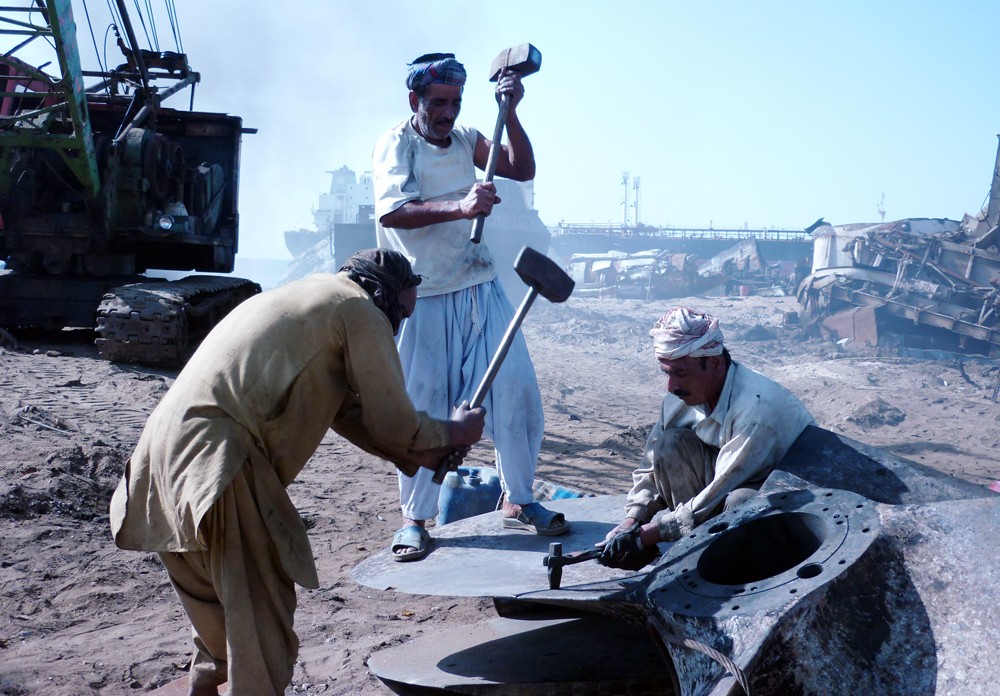
Workers in Pakistan risk their lives working in environments that lack safety and labour standards

It used to be a usual sight, as it invariably happens all around our neighbourhood, noticing the blatant violations of labour safety codes at the famous Rawalpindi Metro Bus project in the summer of 2014. Not only that the commuters remained frenzied and subliminally gripped in a fear of any accident that seemed very likely while grappling within the labyrinth of fragile makeshift arrangements, the labourers too seemed exposed to serious life threatening hazards under those morbid conditions. Eventually, there was an accident in which an unprotected labourer met a collapsing accident.
The accident was clearly an outcome of lacking safety measures and occupational standards. I decided to lodge a complaint with the Punjab government. Through an open letter and also following the proper complaint mechanism, I attempted reminding the government of its obligations and maintained that the responsibility to ensure compliance of statuary Occupational Health and Safety standards by any employer rests on the government. The complaint never received any attention thereto but this made me realise the question on government’s [inapt] ability and fervor to handle the menace of industrial accidents and labour infringements.
Every day, it is widely observed that innumerable work and industrial establishments ostensibly operate in sheer violation of safety and labour standards. The principles these standards espouse are the basic rights that are enshrined in the constitution of Pakistan and also amply, if not fully, imbedded in to our labour laws too. The enforcement of these laws, however, remains a challenge due to weaker labour inspection function. Occupational accidents are mostly caused, amongst others, of weak enforcement of labour laws. Labour inspection is the panacea!
Labour Inspection is one of the core functions of statuary labour administration system and a key element for ensuring the implementation of labour policies, providing feedback and allowing for readjustment of these policies as necessary. A strong labour inspection function needs to provide necessary tools and systems for data management, reporting and checking the infringements.
Over the years, labour inspection largely remained a subject of intricate political interests in Pakistan. A stronger labour inspection function was thus historically viewed as starkly conflicting with the interests of influential [mostly industrial] elites that also at times in the past embarked upon obliteration of labour inspection thru regressive regulatory actions.
The promulgation of the 18th Amendment, that redefined constitutional relationships between provinces and the federation, left labour inspection function further fading amid post-devolution institutional challenges in the provinces. Especially, the ability of provincial labour inspection machinery to cope with the fast pace law reform and escalated regulatory endeavours remains further limited. At present, the institutional capacity of the provincial labour inspection machinery seems considerably intangible.
Higher number of industrial accidents, expanding informal economy, weak social security mechanisms, lack of data management system and reporting competencies are the symptoms that indicate our labour inspection system remains significantly under-developed.
The ailment is deep rooted in to the weak institutional apparatus. The entire labour inspection machinery of Pakistan is [merely] resourced with around 350 labour inspectors and a medieval manual data management [system]. It is such a poorly resourced institutional arrangement that we even don’t know the exact number of industrial establishments in the country let alone their profile data and/or the state of their compliance of the labour codes.
This under resourced apparatus that obviously offers an under-sized basket of competencies should not be fairly expected to carry out technical inspection, use technological tools and enunciate high performance methodologies. A comprehensive institutional strengthening approach to improve the situation cannot be overemphasised thus.
At the outset, a formidable political will to champion the labour inspection apparatus remains at the core of the much needed institutional reformation process. A staunch political consensus, founded on the principle of across-the-board accountability, is desired to meet the necessary condition of having a system that could check the infringements.
Since a large proportion of our political representation belongs to the industrial community, the strengthening of the labour inspection apparatus could thus fall conflicting with the vested interests of a larger constituency. The legislature is therefore required to demonstrate and nurture a stronger commitment that should further pave the way for well-deserved resource allocation.
It is the proportionately allocated resources that further should be invested in advancing the technical capabilities of the labour inspectorates. An efficient inspection function will nevertheless require a coherent system of technology based data collection gadgets, tools and abundance of technical skills in order to manage and use the data as an efficient way of keeping checks on infringements. The inspecting force will also be required to have an in-depth understanding of their functions as well as theoretical knowledge of their domain, thereby efficiently applying the modern inspection system.
A modern labour inspection system cannot be applied without a proper human resource management system. This aspect of the reform process requires application of an incentivised performance based reward system for high achievers. The reward system, however, should come in force by means of close monitoring as well as appropriate facilitation to carry out this tiresome task of visiting industrial establishments. Only a well-established monitoring system could help in escalating the organisational accountability and advancing the much needed labour inspection procedures efficiently.
Last but not the least, an alternate responsive complaint redressal mechanism could be worked out that should discharge two essential services. Firstly, the complaint redressal system should be made repository of making and enforcing decisions. Secondly, the envisaged complaint redressal system should also be empowered to investigate and bring infringements into the notice of existing labour judicial system.